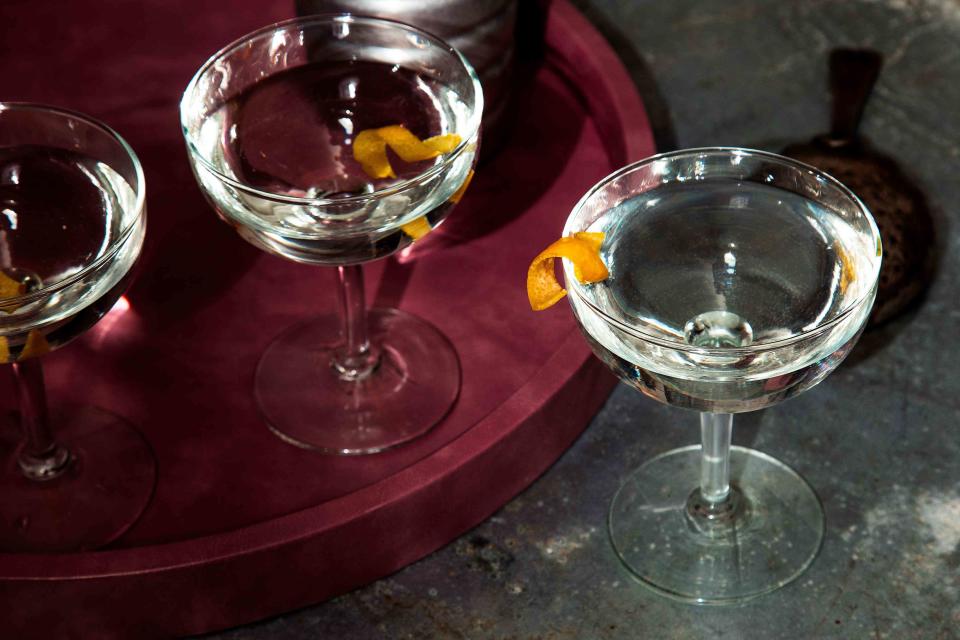Why Aren't We Drinking More 50-50 Martinis?
It's never been a better time for a more sessionable, sociable version of this iconic cocktail.

Matt Taylor-Gross
The first time I asked for a 50-50 Martini to accompany my preferred nightcap of well-salted fries with a dollop of ketchup, I watched as my server registered my order with a mix of confusion and doubt — a Martini, sure, but 50-50?
Most bars and restaurants are well-equipped to make the classic cocktail bone dry, dirty, or even filthy, and also know to ask whether you’d like to enjoy it with olives or a twist, shaken or stirred. Even the choice of base spirit — gin or vodka — is up for discussion. But of all the Martini riffs I’ve ordered, the 50-50 is the one I’ve had to clarify the most often, and I have to wonder: Why aren’t more people drinking what I consider to be the perfect Martini?
Related: Our Best Martini Recipes
With the rise of thoughtfully crafted low-alcohol cocktails and spirits, the 50-50 Martini, which calls for one part gin and one part vermouth, is right on trend. While most places with a full bar will technically be able to make one without issue, I’ve noticed it featured on cocktail lists by name at spots like Layla, a new bar in Williamsburg, Brooklyn, as well as at the Commerce Inn, an homage to Shaker cuisine from chef-restaurateur duo 1993 F&W Best New Chef Jody Williams and Rita Sodi. “The 50/50 Martini has a lower ABV and more savory notes making it more of an aperitivo style,” Williams explains to me. “While devoted Martini drinkers have their preferences from bone-dry to dirty, the 50/50 becomes an entirely new religion…crisp yet less dry, with more flavorful top notes from the additional vermouth.”
At the Commerce Inn (and other spots that know a thing or two about a good Martini, like Bemelmans Bar at the Carlyle Hotel) orange bitters are also part of this simple equation, as is a lemon twist.
Related: Here's How to Make the Best Martini in NYC
Like so many classic cocktails, the 50-50’s origins lead back to The Savoy Cocktail Book, a cocktail guide from 1930 that features a simple recipe for a “Medium Martini” that calls for 1/4 ounce of Italian vermouth, 1/4 ounce of French vermouth, and 1/2 ounce of dry gin. Roughly 75 years later, New York City’s now-shuttered Pegu Club featured the drink under a more playful title — the Fitty-Fitty — a move that cocktail writers like Robert Simonson credit with putting the cocktail back on the modern day map.
“The [classic] Martini did begin life as an equal-parts drink. But those parts, in the late 19th century, were Old Tom gin, a sweeter form of the spirit, and sweet vermouth,” writes Simonson for PUNCH. “It wouldn’t be until after 1900 that a 50/50 Martini with dry gin and dry vermouth would appear. Nonetheless, for history-conscious young bartenders who were bent on returning every classic cocktail to its former glory, the 50/50 was a revelation.”
Related: Our Favorite Martinis of 2022
As someone who isn’t always looking for the boozy punch of a Martini but still craves its refreshing simplicity, the 50-50 is my version of a beautiful compromise. I still get to enjoy the flavors of my go-to gin (Ford’s, if you’re wondering, though I’m also partial to the wonderfully botanical-forward Forthave Blue, which I swear I discover a new layer to every time I make a drink). The 50-50 Martini also lets me taste the citrusy, herbaceous notes that I love in vermouth, and discover one I might later use to make a Vermouth Spritz.
As I enter my thirties, the reality is that I’m excited about a more reasonable, more responsible Martini, one that accepts how much worse my mornings feel now compared to how they used to feel, especially if I’ve had one more drink to keep the company and conversation going. After I’ve drained the last drop of my 50-50 Martini, I’m not only in better shape to try another cocktail, but I might also order a glass of wine or amaro. The 50-50 makes for a more social, less dehydrated, better rested version of myself, and well, what doesn’t sound appealing about that?
For more Food & Wine news, make sure to sign up for our newsletter!
Read the original article on Food & Wine.

